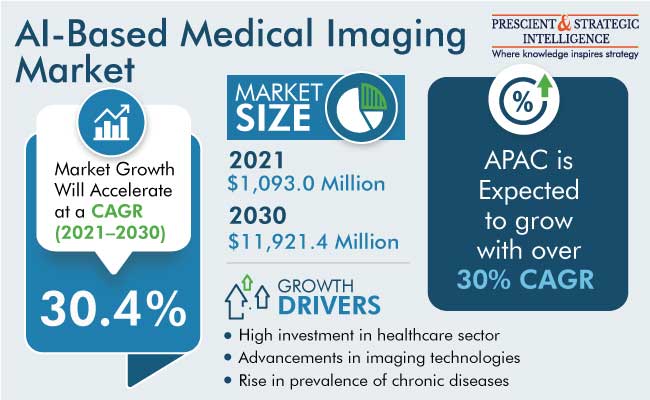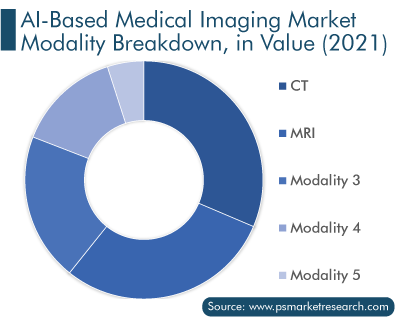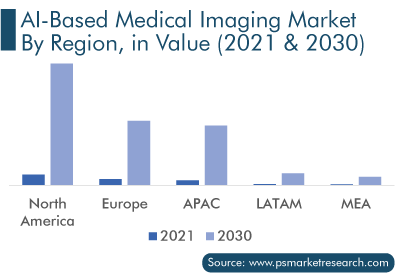Report Code: 12416 | Available Format: PDF | Pages: 210
AI-Based Medical Imaging Market Size and Share Analysis Report by Technology (Deep Learning), Modality (CT, MRI, X-Ray, Ultrasound, Nuclear Imaging), Application (Neurology, Pulmonology, Cardiology, Orthopedics), End User (Hospitals, Diagnostic Imaging Centers) - Forecast to 2030
- Report Code: 12416
- Available Format: PDF
- Pages: 210
- Report Description
- Table of Contents
- Market Segmentation
- Request Free Sample
Market Overview
The global AI-based medical imaging market size was valued at $1,093.0 million in 2021, and it is expected to generate $11,921.4 million revenue by 2030, advancing at a robust CAGR of 30.4% during 2021–2030. The major factors driving the industry include the rising prevalence of chronic diseases, increasing demand for medical services for the aging population, and surging R&D spending in the healthcare sector. Moreover, the continuous advancement in the field of imaging technology and the rise in government initiatives will further drive the market in the coming years.

Technological Advancements in Healthcare Sector Boost the Market
Digitization and new technological developments in the healthcare sector play a major role in the market growth. The most prominent advancement in the sector is AI-based technologies, such as medical imaging, which are used for early detection of diseases, better diagnosis, and patient-specific treatments. AI has vast applications in the field of medical imaging, due to its accuracy and sensitivity in identifying abnormalities. Moreover, the ongoing advancements in imaging technologies, such as computer-aided diagnostics, is another factor responsible for the speedy growth of the industry.
CT Generates the Majority of Market Revenue
Computed tomography (CT) held the largest revenue share, of over 30%, in 2021, and the category is expected to maintain its leading position in the forecast period as well. This is attributed to the rising incidence of numerous chronic diseases such as cancer and cardiovascular conditions as well as the increasing need for AI-integrated advanced imaging solutions. Moreover, the AI-based medical imaging market growth in this category is also driven by the significant investment specifically for the development of AI-enabled solutions, the vast population affected by cancer and other chronic diseases, and the large number of small and key players that provide a wide range of AI-based CT imaging diagnostic solutions.
However, the MRI category is projected to witness the fastest growth among all modalities during 2021–2030. This growth can be attributed to the rising usage of AI-based techniques to measure the structure and function of the heart, which help cardiologists provide appropriate patient care and treatment. In addition, several market giants and small vendors are engaged in the development of AI-based medical imaging solutions associated with MRI, which also fuel the overall market growth in this category.

Deep Learning Accounts for Largest Revenue Share
Deep learning technology accounted for the larger revenue share, of around 50%, in 2021, and the category is also expected to dominate the market in the forecast period. This is due to its excellent extraction capabilities and its high usage in identifying and distinguishing bacterial and viral pneumonia on pediatric chest radiographs.
Hospitals Dominate the Market
The hospitals category contributed the largest revenue to the market in 2021, and it is projected to advance with a CAGR of over 30% during the forecast period. This is attributed to the omnipresence, easy accessibility, and preference of hospitals over other medical centers or facilities. In addition, reimbursement policies are one of the major factors behind the dominance of the category in the market.
Furthermore, the diagnostic imaging centers category is expected to record the fastest growth during the forecast period. This can be because these centers have advanced equipment for performing MRIs or CT scans at lower costs than hospitals. Also, the rising awareness among patients and the increasing demand for diagnostic procedures or tests in these centers will propel the AI-based medical imaging market in this category in the coming years.
| Report Attribute | Details |
Historical Years |
2017-2021 |
Forecast Years |
2022-2030 |
Market Size in 2021 |
$1,093.0 Million |
Revenue Forecast in 2030 |
$11,921.4 Million |
Growth Rate |
30.4% CAGR |
Report Scope |
Market Trends, Drivers, and Restraints; Revenue Estimation and Forecast; Segmentation Analysis; Impact of COVID-19; Companies’ Strategic Developments; Company Profiling |
Segments Covered |
By Technology; By Modality; By Application; By End User; By Region |
Explore more about this report - Request free sample
Neurology Contributes Majority of Revenue to the Market
Neurology accounted for the majority of revenue share, of over 25%, in 2021, and the category is expected to grow with a significant CAGR during the forecast period. This is ascribed to a large number of vendors engaged in the development of AI-based medical imaging technologies and devices for neurological diseases, whose prevalence is high across the world, and high medical imaging data in this area.
Rising Preference of Doctors for AI-Based Assistance
The growing awareness of the benefits of AI techniques and their broad application areas has resulted in the high implementation of AI in the medical diagnostic sector. Several market players are partnering or collaborating to offer the most prominent technologies to their consumers in the field of healthcare. These AI-based medical technologies significantly aid clinicians and doctors in their decision-making concerning diagnosis and treatment. Thus, doctors are inclined to adopt these cost-effective, near-to-accurate, and safe solutions over the traditional ones, which, in turn, boosts the market growth.
North America Accounts for Largest Market Share
The North American AI-based medical imaging market holds the largest revenue share, and it is expected to maintain the same trend in the coming years as well. This is attributed to the high adoption of advanced technologies in the healthcare sector and the presence of major market players in the region. Moreover, the rise in partnerships and collaborations among vendors, the significant role of research institutions in the development of AI-based medical imaging solutions, and the high investments in R&D and healthcare drive the regional market growth. In North America, the U.S. leads the market, due to the well-established healthcare system, the presence of a large number of local and international players, and the improved reimbursement policies in the country.
On the other hand, the APAC market is expected to witness the highest growth rate during the forecast period, advancing with a robust CAGR of over 30%. This exponential growth can be attributed to the growing aging population, surging demand for healthcare services, and increasing investments or funding by various government and private players in the region. Moreover, emerging economies such as China and India are emphasizing on improving their AI investments, which will assist companies in integrating AI with medical imaging to massively increase their revenue share.

Strategic Development by Market Players to Gain a Competitive Edge
To maintain a strong market position, players have adopted several strategies, including collaborations, partnerships, acquisitions, investments, and product launches, to remain competitive. For instance:
- In July 2022, Agfa Gevaert N.V. and Northwest Clinics extended the contract of collaboration and added RUBEE for AI platform to the enterprise imaging solution.
- In February 2022, Siemens Healthineers and Universal Medical Imaging Group collaborated to assist primary healthcare facilities in China to increase the effectiveness of their image screening and disease diagnosis via cutting-edge imaging diagnostic tools and remote scanning assistant technologies.
Key Players in the AI-Based Medical Imaging Market Are:
- Agfa Gevaert N.V.
- Siemens Healthineers
- EchoNous Inc.
- Enlitic Inc.
- General Electric Company
Market Size Breakdown by Segment
The study offers a comprehensive market segmentation analysis along with market estimation for the period 2017-2030.
Based on Technology
- Deep Learning
Based on Modality
- CT
- MRI
- X-Ray
- Ultrasound
- Nuclear Imaging
Based on Application
- Neurology
- Pulmonology
- Cardiology
- Orthopedics
Based on End User
- Hospitals
- Diagnostic Imaging Centers
Geographical Analysis
- North America
- U.S.
- Canada
- Europe
- Germany
- France
- U.K.
- Italy
- Spain
- Asia-Pacific
- China
- India
- Japan
- Australia
- South Korea
- Latin America
- Brazil
- Mexico
- Middle East and Africa
- Saudi Arabia
- South Africa
The AI-based medical imaging market size stood at $1,093.0 million in 2021.
During 2021–2030, the growth rate of the AI-based medical imaging market will be 30.4%.
Neurology is the largest application area in the AI-based medical imaging market.
The major drivers of the AI-based medical imaging market include the high investment in the healthcare sector by different governments and industry giants, the advancements in imaging technologies, and the rise in prevalence of chronic diseases across the world.
Want a report tailored exactly to your business strategy?
Request CustomizationWant an insight-rich discussion with the report author?
Speak to AnalystOur dedication to providing the most-accurate market information has earned us verification by Dun & Bradstreet (D&B). We strive for quality checking of the highest level to enable data-driven decision making for you
Our insights into the minutest levels of the markets, including the latest trends and competitive landscape, give you all the answers you need to take your business to new heights
With 24/7 research support, we ensure that the wheels of your business never stop turning. Don’t let time stand in your way. Get all your queries answered with a simple phone call or email, as and when required
We take a cautious approach to protecting your personal and confidential information. Trust is the strongest bond that connects us and our clients, and trust we build by complying with all international and domestic data protection and privacy laws